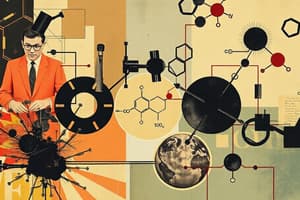Podcast
Questions and Answers
How does a straight-chain alkane that has five carbon atoms differ from a cycloalkane that has five carbon atoms?
How does a straight-chain alkane that has five carbon atoms differ from a cycloalkane that has five carbon atoms?
not d
Why do thicker lubricating oils have higher melting points?
Why do thicker lubricating oils have higher melting points?
A
Which alkane is the isomer of butane called 2-methylpropane?
Which alkane is the isomer of butane called 2-methylpropane?
B
Saturated hydrocarbons with what length of carbon chain are the best lubricants?
Saturated hydrocarbons with what length of carbon chain are the best lubricants?
What is the name of this hydrocarbon?
What is the name of this hydrocarbon?
What is the name of this alkane?
What is the name of this alkane?
What is a property of all alkanes?
What is a property of all alkanes?
When is di- used in the name of a hydrocarbon?
When is di- used in the name of a hydrocarbon?
Which prefix is used to indicate that the main chain of a hydrocarbon contains four carbon atoms?
Which prefix is used to indicate that the main chain of a hydrocarbon contains four carbon atoms?
Which of these compounds would most likely be found in a deposit of natural gas?
Which of these compounds would most likely be found in a deposit of natural gas?
What is the name of this hydrocarbon?
What is the name of this hydrocarbon?
Which lists straight-chain alkanes from lowest to highest boiling point?
Which lists straight-chain alkanes from lowest to highest boiling point?
How does a straight-chain alkane that has five carbon atoms differ from a cycloalkane that has five carbon atoms?
How does a straight-chain alkane that has five carbon atoms differ from a cycloalkane that has five carbon atoms?
A plastic that is composed of a saturated hydrocarbon would have molecules that are most like those in which material?
A plastic that is composed of a saturated hydrocarbon would have molecules that are most like those in which material?
Flashcards are hidden until you start studying
Study Notes
Properties of Saturated Hydrocarbons
- Straight-chain alkanes and cycloalkanes differ in structure: alkanes are linear while cycloalkanes are cyclic.
- Longer carbon chains (17-35 carbon atoms) in saturated hydrocarbons serve as excellent lubricants due to their viscosity and stability.
Characteristics of Alkanes
- All alkanes share common properties, such as being nonpolar and hydrophobic, influencing their behavior in different environments.
- Thicker lubricating oils tend to have higher melting points because their larger molecular structure leads to stronger intermolecular forces.
Nomenclature and Structures
- 2-methylpropane is an isomer of butane, showcasing how carbon atoms can arrange differently while maintaining the same molecular formula.
- The prefix "di-" is used when there are two identical groups of atoms within a hydrocarbon molecule.
- The main chain of a hydrocarbon containing four carbon atoms is denoted by the prefix "but-".
Identification of Specific Hydrocarbons
- 2,3-dimethylpentane and 2-methylbutane are specific hydrocarbons with distinct structures, important for identification and classification in organic chemistry.
Natural Gas Composition
- Compounds found in natural gas often include smaller alkanes, emphasizing the characteristics of saturated hydrocarbons in fuel sources.
Boiling Points of Alkanes
- Straight-chain alkanes exhibit a range of boiling points; understanding their order from lower to higher is key in predicting their physical properties.
Studying That Suits You
Use AI to generate personalized quizzes and flashcards to suit your learning preferences.




